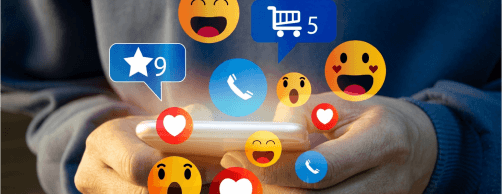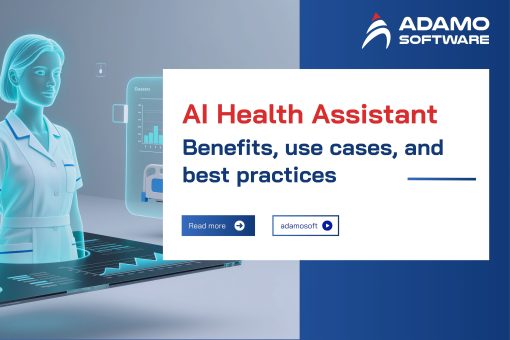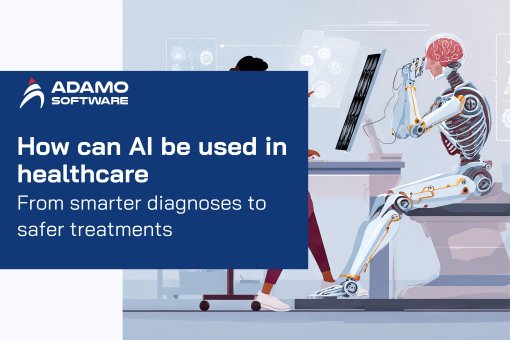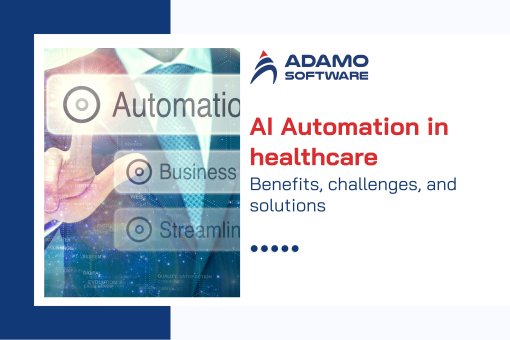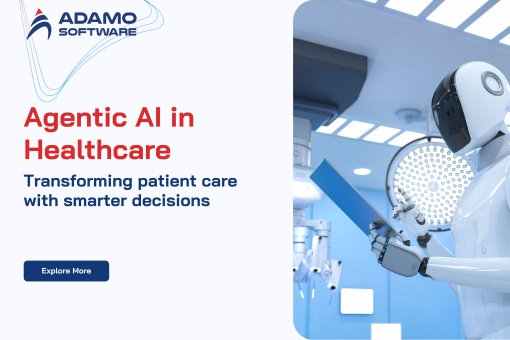Personal Health Records: A comprehensive guide
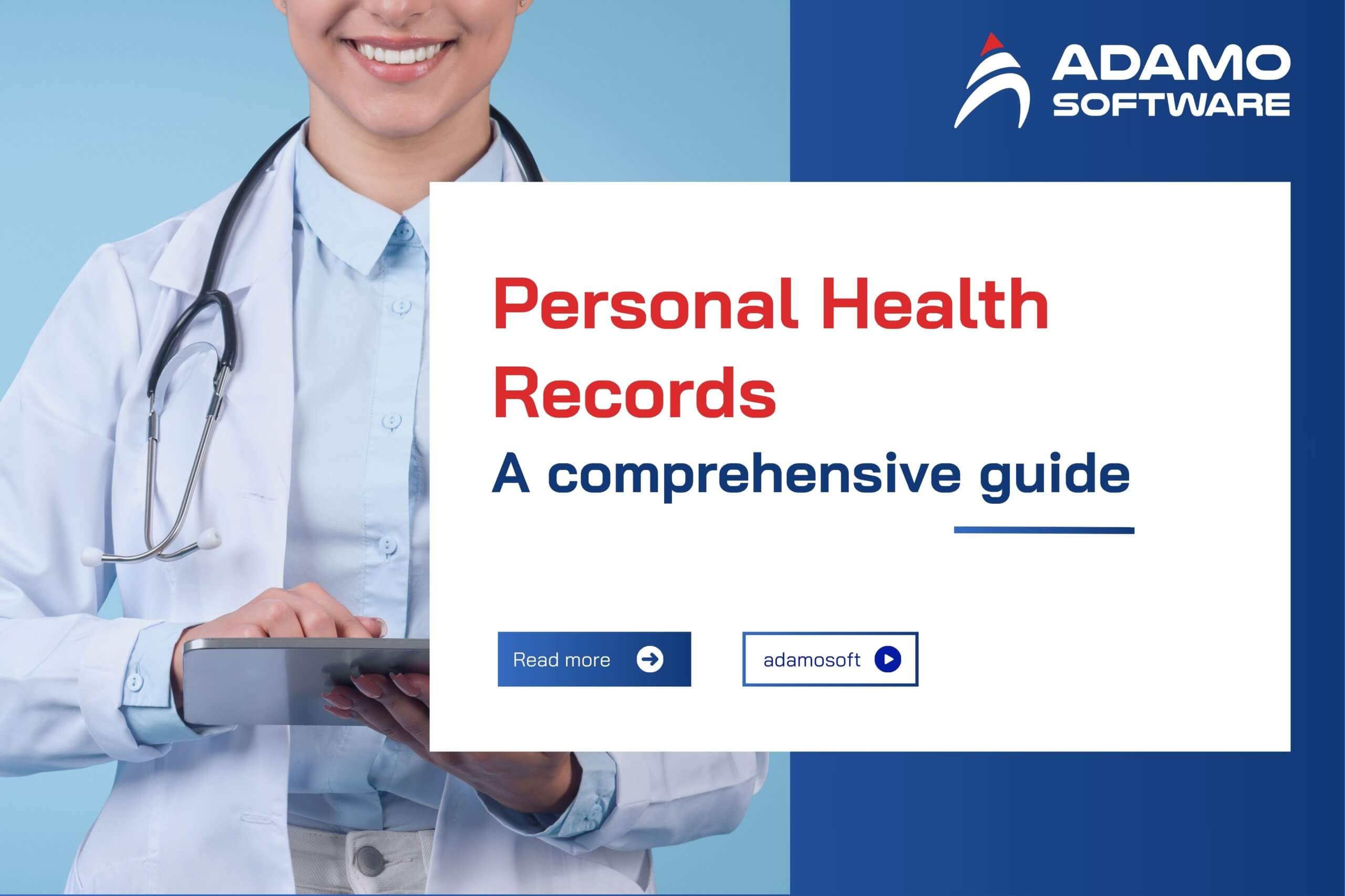
Personal health records have become a popular tool for patients to monitor their health condition and medical data. Let’s explore the system with Adamo Software!
In today’s digital era, personal health records have become a popular tool for patients to monitor their health condition and medical data. Thanks to the ability to continuously track the data, this tool not only helps to enhance treatment efficiency but also prevents disease. Technological advancement has allowed the personal health record to integrate with many innovative features, bringing a more convenient healthcare experience. Let’s learn about this tool with Adamo Software.
Through this blog post, you will have some insights about the definition of a personal health record, its benefits, and challenges. Besides, you will also know some healthcare systems that integrate with PHR. All the information has been thoroughly researched and updated with the latest trends. So, let’s read our post and find some useful information!
I. What are Personal Health Records?
A personal health record is a medical system that stores the patient’s medical data, helping patients proactively monitor their health status. Personal health records come in two forms, including paper records and electronic records. However, in the digital world, healthcare facilities are turning to electronic personal health records instead of paper documents.
There are four main information sections in a personal health record, which are administrative information, information on medical history and health-related factors, vaccination information, and clinical information and conclusions on health status.
1. Administrative information
Administrative information is a basic information type of personal health records. It includes full name, date of birth, gender, address, telephone number, patient identification number (if applicable), health insurance, and emergency contact information. Thanks to these pieces of information, doctors can correctly identify their patients and ensure that the patients can receive the right medical treatment and services.
2. Information on medical history and health factors
This section documents patient medical history, including illnesses, conditions, allergies, surgeries, and risk factors. With these pieces of information, doctors can diagnose and treat effectively. Besides, as patients can access and manage their data, they can better understand potential risks to their health.
3. Vaccination information
The personal health record’s vaccination information plays an important role in preventing disease. This information is especially useful for patients who are likely to get a disease and have poor resistance. A PHR will detail vaccine type, dates, doses, side effects, and boosters. This simplifies immunity and vaccination schedule tracking.
4. Clinical information
Your personal health record cannot be missed by the clinical information. This includes test results, imaging, ECG, and vital signs. Additionally, the record also includes doctor assessments, aiding treatment and decisions.
Overall, the personal health record allows patients to monitor health, allergies, medications, and medical history. As patients can access the data and enter the data themselves, they can be more proactive in making decisions related to their health. Besides, the personal health record also supports doctors in making in-time decisions effectively.
II. Benefits of Personal Health Record System
The personal health record system is vital for patient health management. This system offers numerous benefits to patients, doctors, and facilities. It improves health management and healthcare. Let Adamo Software discuss these benefits in detail.
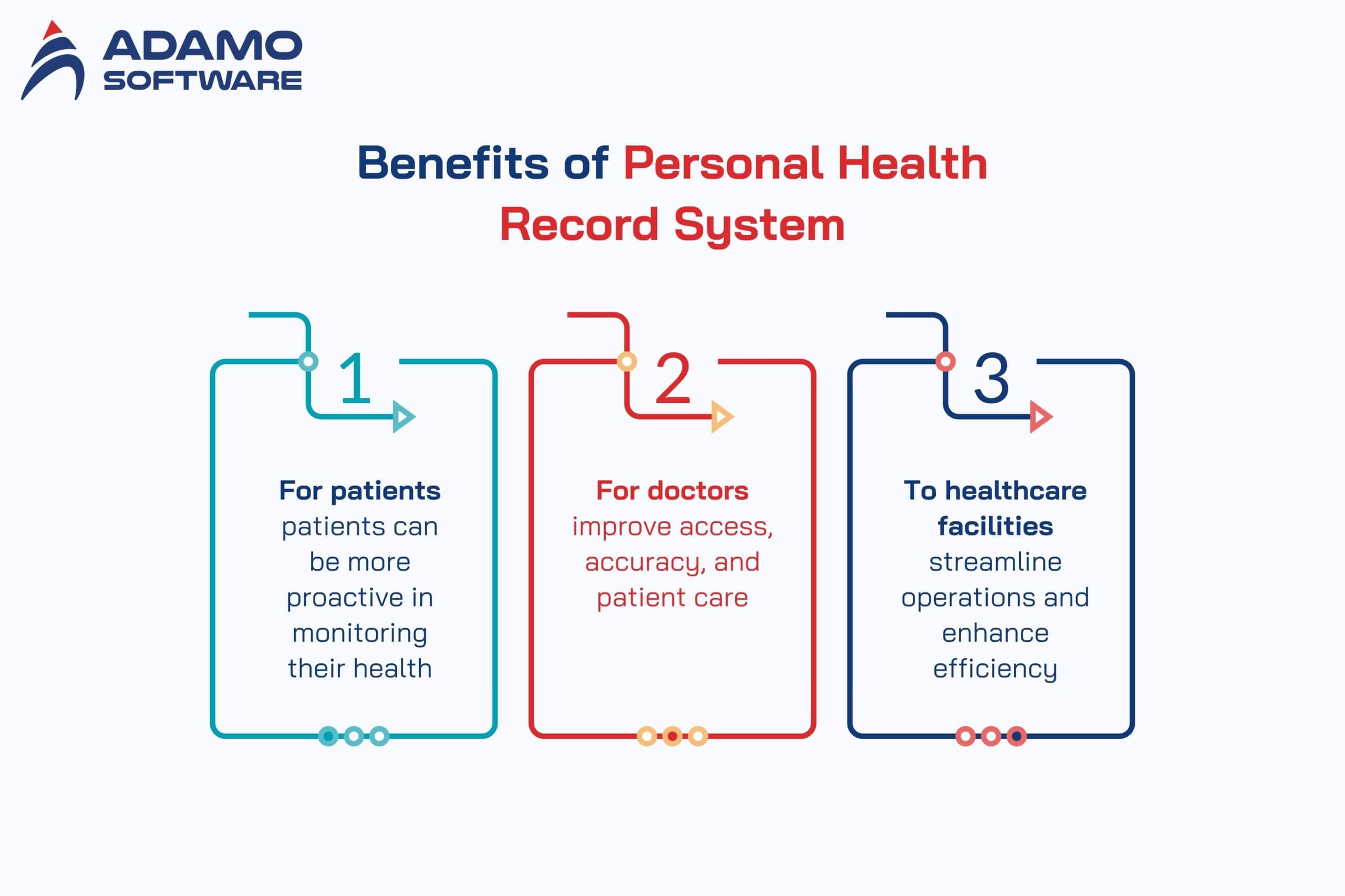
1. The benefits of a personal health record system for patients
With the personal health record, patients can be more proactive in monitoring their health. Digital systems allow patients to access the data anytime, anywhere they are without going to the hospital to ask doctors about their condition.
Firstly, this system enhances patient health management. Patients will no longer have to keep and find data from paper documents. Instead, they can view them digitally. Thus, they can monitor trends, detect early issues, and enhance self-care.
Besides, the smart reminder function of the personal health record is helpful. Patients can get notifications about essential health activities, such as medications, checkups, and vaccinations. The system also tracks vital signs like blood pressure, glucose, weight, and exercise. This empowers effective health management. The reminder functions and online support healthy habits and consistent treatment, enhancing treatment effectiveness.
Additionally, the personal health record system helps patients easily monitor their health through the visualization health report function. This PHR feature presents health data visually, using charts, graphs, and trend analyses. Patients may struggle to interpret complex test results. Therefore, the visualization function is extremely useful for them. Patients can see health trends in blood pressure, glucose, heart rate, etc., with visual aids. Moreover, the personal health record system employs robust security measures, ensuring patient control over their data. Patients can set privacy, allowing doctors or close relatives to access their health information only when necessary. This reduces data breaches, ensures privacy, and fosters user trust.
You can explore more about Patient engagement software: Features, tech stacks and useful tips here.
2. The advantages of a personal health record system for doctors
The personal health record system also benefits doctors. It is crucial to patient diagnosis and treatment. Digital medical records improve access, accuracy, and patient care.
The personal health record helps doctors access patient’s medical data quickly. Thanks to the system, doctors will no longer have to depend on paper records or hospital medical records management systems to know the patient’s condition, which takes a lot of time and may lead to a lack of information. Instead, the personal health record allows doctors to instantly view medical history, test results, prescriptions, allergies, and vital health indicators.
Besides, the system also enhances diagnosis quality and minimizes treatment risks. Complete patient data allows doctors to consider relevant factors before prescribing or treating. This minimizes side effects and avoids ineffective treatment. The system supports chronic disease management through monitoring and treatment adjustments.
Additionally, the personal health record system also helps doctors remotely monitor and manage care. Doctors can maintain consistent patient monitoring remotely, even when patients do not go to the hospital regularly. Some systems facilitate real-time monitoring of critical physiological data, such as heart rate, blood pressure, and glucose levels. This is especially helpful for elderly, chronic, and post-surgical patients.
Additionally, the personal health record system also helps doctors better coordinate with other medical professionals. Patients frequently require multidisciplinary care. Consequently, collaborative efforts between healthcare facility departments are crucial. For example, with access to records from other specialists, internists can make more accurate treatment decisions.
Overall, the personal health record system provides benefits to both patients and doctors, leading to improved healthcare quality. The system streamlines workflow minimizes errors and enhances collaboration.
3. The benefits of personal health records to healthcare facilities
Beyond patient and physician benefits, personal health record systems streamline operations and enhance efficiency in medical facilities. The system helps hospitals and clinics manage patients better, provide better service, keep information safe, and follow all the rules.
With personal health records, healthcare facilities can reduce the time and effort spent on managing patient records. Digital platforms replace paper records, reducing administrative workload. This streamlines access and minimizes data loss and errors. Besides, the system helps to speed up information processing during medical examination and treatment. Instead of re-entering information, staff can quickly access previous records, optimizing workflow for ongoing patient care.
In addition, the personal health record system also helps healthcare facilities improve medical examination and treatment quality. Organized patient data facilitates efficient, accurate treatment decisions. This is crucial for emergencies and complex coordinated care.
Furthermore, the system helps healthcare facilities avoid legal risks related to information security. Personal health records incorporate secure encryption and authentication technologies to mitigate the risk of data breaches and unauthorized access. Additionally, implementing the system also saves significant costs for healthcare facilities. The system helps to minimize the use of paper records, reducing errors in data management and optimizing workflows.
In general, the personal health record system provides equal benefits to patients, doctors, and medical facilities. The integration of PHR systems contributes to enhanced clinical outcomes and patient satisfaction.
Explore Our Tailor-made Software Development Solutions
We are confident in providing end-to-end software development services from fully-functioned prototype to design, MVP development and deployment.
III. Challenges of Personal Health Records
Despite the advantages to patients, doctors, and medical centers, implementing a personal health record system faces many challenges. Data accuracy, security, privacy, and access disparities are key barriers to PHR effectiveness. Let’s find out more detailed information about these difficulties with Adamo Software!
Data Accuracy
Data accuracy is one of the largest challenges of integrating personal health records into existing systems of hospitals. Because patients have control over data entry, the system is susceptible to data errors and omissions. Incorrect patient data can lead to inappropriate treatment decisions. This strongly affects the effectiveness of healthcare.
Besides, inaccurate information may come from inconsistencies between sources. Patient records can be updated from multiple sources, such as clinics, hospitals, wearables, healthcare apps, etc.
Data from these sources may differ, leading to discrepancies in information in personal health records. This reduces the reliability of the system. To address this issue, implementing automated data validation and information reconciliation between patients, doctors, and health systems is essential. Besides, patients should be guided on how to accurately extract and interpret information from prescription labels and test reports.
Data security and privacy
Data security and privacy are a concern for every industry. And so does healthcare. When implementing personal health records, you must concentrate on them. Due to the sensitivity of patient information, the potential for data leakage or unauthorized access requires significant attention. Poor security leads to data theft, fraud, and misuse.
Patients may be concerned about who has the right to access their data. Without the right controls, the patient’s data could be misused. Thus, the personal health record system must be integrated with data encryption, two-factor authentication, and role-based access restrictions. This helps to ensure robust security standards.
Besides, this system is currently not complying with some security regulations like HIPAA (USA) or GDPR (Europe). This puts the system on whether it is secure or not. Thus, the personal health record must be upgraded and comply with the above standards. Stronger security and compliance improve reliability and user protection.
Disparities in adoption rates
Disparities in adoption rates remain a challenge when implementing the personal health record. Currently, the use of the system is still inconsistent among patients and healthcare providers. Not all clinics and hospitals are ready to integrate PHRs into their patient management systems. This limits data sharing between different healthcare facilities. In case a patient transfers to another hospital but their record does not have enough data, the new hospital that accepts them may have difficulties in looking up and synchronizing data.
Besides, many patients lack the necessary knowledge or resources to effectively utilize personal health records. Accessing the system may be difficult for elderly, low-tech, and rural patients. Thus, personal health record education is needed to improve system use and improve patient-doctor interactions through digital platforms. Additionally, investment in tech infrastructure is needed for equitable PHR access.
IV. Integrating PHR with healthcare systems
While the personal health record can be utilized independently by patients, it can also integrate with other healthcare platforms to enhance patient care. Through the integration of PHRs and platforms like EHRs, e-prescriptions, medication histories, and appointment systems, patients achieve greater health data visibility, and healthcare facilities can achieve more efficient medical care operations. Below are some healthcare systems that can integrate with the personal health record.
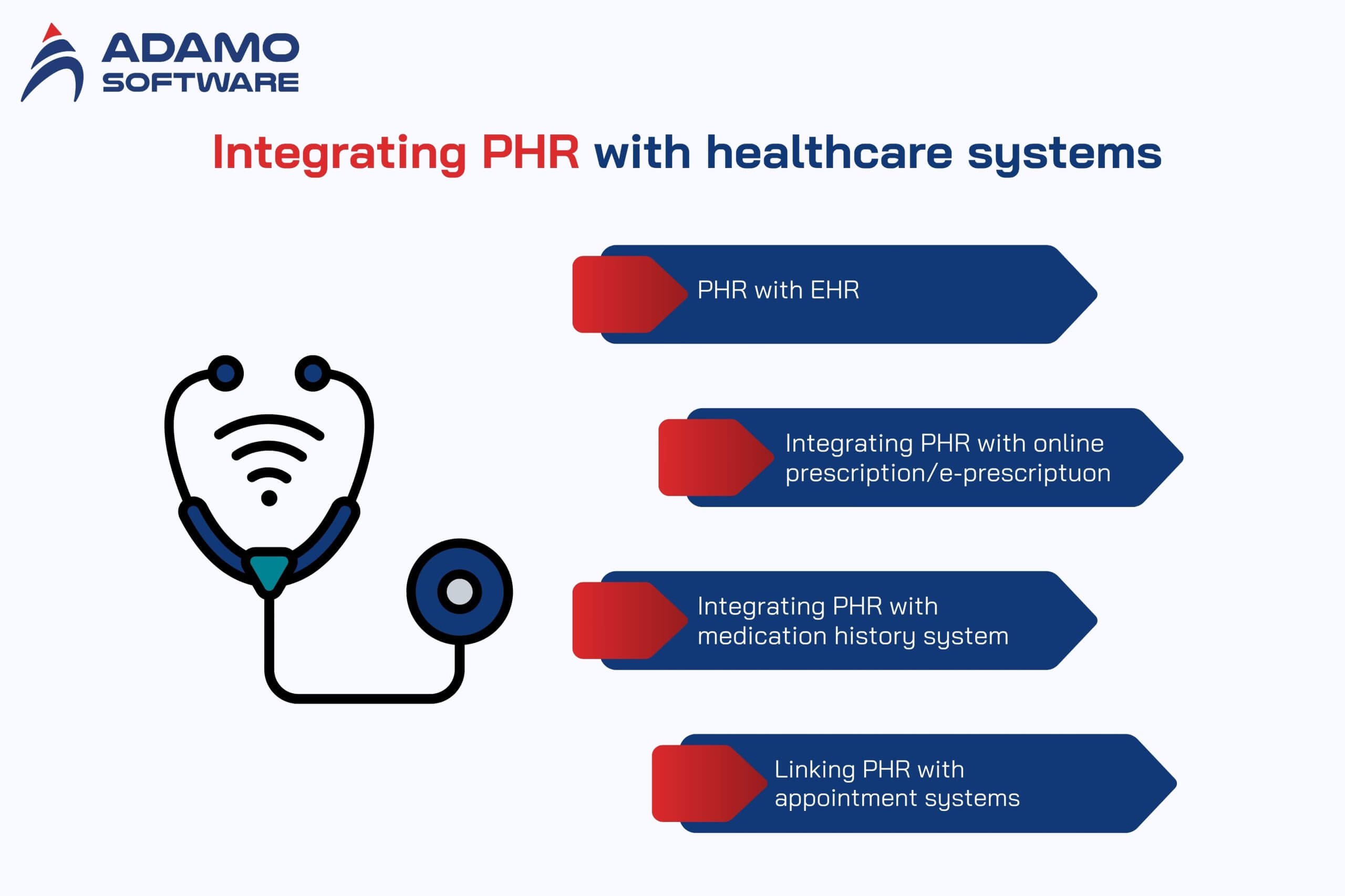
PHR with EHR
Electronic health records (EHRs) are digital health records commonly used by healthcare facilities. It collects individual health data stored on an electronic system. Connecting PHRs and EHRs facilitates a collaborative view of a patient’s medical history for patients and their healthcare providers. Rather than having patient data dispersed among many hospitals and clinics, PHRs consolidate information from different EHR systems. This minimizes redundant data entry and ensures clinicians have comprehensive patient information for informed treatment decisions.
Integrating PHR with online prescription/ e-prescription
The personal health record can be integrated with an online prescription function to streamline prescription management. Patients can review their history, get reminders, and request refills online. Besides, this integration allows doctors to review past medication history, helping them avoid medication duplication or adverse drug interactions.
Real-time PHR updates ensure accurate prescriptions, medication tracking, reminders, and provider communication. Seamless integration streamlines prescriptions, enhances patient engagement and improves medication safety.
Integrating PHR with the medication history system
Linking PHR to the medication history system helps patients and doctors track their treatment more effectively. Patients can review medications, effectiveness, and side effects. Doctors can adjust treatments based on this data for safety and effectiveness. Real-time data improves decisions, prevents interactions, and customizes treatment. Overall, integrating the personal health record with medication history systems enhances patient safety and promotes more efficient healthcare outcomes.
Linking PHR with appointment systems
Connecting the personal health record to an appointment scheduling system makes it easy for patients to track and manage their medical appointments. Users can receive reminders, check their medical history, and schedule new appointments right on the PHR system without having to contact the medical facility directly.
For doctors and medical staff, this integration helps optimize work schedules, minimizing duplicate appointments or last-minute cancellations. Through PHR integration with appointment systems, healthcare administration is simplified by centralizing scheduling information, thus enhancing patient experience.
In general, integrating the personal health record with different healthcare systems helps create a comprehensive healthcare service, improving treatment efficiency and improving the experience of both patients and doctors. When these systems are synchronized, medical data becomes more transparent, the medical examination and treatment process is optimized. This contributes to building a more efficient healthcare system.
V. Work with Adamo Software for a custom personal health record system
A customized personal health record (PHR) system can help patients, physicians, and healthcare facilities manage data more efficiently. If you are looking for a partner to help you with this, Adamo Software can be your ideal choice. As one of Vietnam’s leading technology companies with many years of experience working in healthcare software development, Adamo Software can be your reliable partner. Here’s how we can help.

Designing and developing a custom personal health record system
Adamo Software provides on-demand PHR development services, helping you build systems that fit your workflow and specific needs. Adamo’s team of experts can design a user-friendly interface, ensuring a smooth user experience, while integrating smart features such as health index tracking, medication reminders, and visual health report displays.
Integrating PHR with other systems
Adamo Software supports you in integrating the personal health record with your existing systems, such as EHR, e-prescription, etc. Synchronizing data between platforms helps reduce errors, improve treatment efficiency, and enhance patient experience.
Ensuring security and compliance with medical regulations
Information security is always a top priority when developing a PHR system. Adamo Software applies advanced security technologies such as data encryption, two-factor authentication, and strict access control to protect patient information. In addition, the system is designed to comply with security and privacy standards such as HIPAA (USA) and GDPR (Europe). So, you will not have to be worried about violating legal regulations.
Providing flexible.mmmmvcl deployment and long-term support
Adamo Software offers flexible deployment models, from web-based PHR systems to mobile applications, making it easy for patients to access and manage their health records anytime, anywhere. Simultaneously, Adamo is committed to providing long-term system maintenance and upgrade services, ensuring that PHR always operates stably, is updated with the latest technology trends, and is suitable for the changing needs of the healthcare industry.
Still hesitating about whether to choose Adamo Software as your partner? Let’s contact us for more detailed information.




